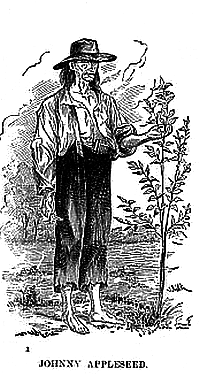Leadership
Lessons from Johnny Appleseed
Ever since my Kindergarten class took a
field trip to a local apple orchard in September 1973, I’ve been a perennial fan
of Johnny Appleseed. The pioneer hero who headed west from his New England home
to bring apple trees to the pioneers (and Native Americans) captured my
imagination at an early age and has never let it go. Johnny has many exemplary
lessons to teach up-and-coming leaders of today. Venturing outside your comfort
zone to explore what lies beyond the horizon, building bridges of peace and
understanding through generosity, and promoting self-sufficiency in harmony
with sustainable growth are just a few of the gems that we can glean from
learning about Johnny and his life story. Just like Johnny, our leaders can
become trailblazers, peacemakers, and philanthropists – and our need for these
types of people only grows with each passing year, as our global civilization
continues to expand and grow in new and unexpected ways.
Johnny Appleseed: Pioneer
Nurseryman
By
Rob Chappell, JSMT Advisor
Adapted
and Expanded from Cursus Honorum VI: 3 (October 2005)
Johnny Appleseed, one of America’s most
beloved homegrown heroes, has been the subject of countless poems, folksongs,
novels, plays, and even a Walt Disney cartoon. Johnny’s appeal has vastly
increased over the past fifty years, concurrent with the emergence of global
concern over rampant deforestation and the drive to develop sustainable
agriculture on a worldwide scale. Behind the larger-than-life legend of Johnny
Appleseed, however, there was once an admirable historical person: John
Chapman, a pioneer nurseryman from New England.


This woodcut of John
Chapman appeared in Howe’s Historical Collections of
Ohio (Ohio Centennial Edition, 1903). (Image Credit: Public
Domain via Wikimedia Commons)
John Chapman was born on September 26, 1774 near Leominster,
Massachusetts. Details of his childhood are sketchy, but he learned to read and
write at an early age and evidently chose to follow an arboricultural career in
his teens, for by the time he was 25, he had already planted apple orchards in
the western counties of New York and Pennsylvania. During the early 1800s, he
pushed farther west into Ohio, Indiana, and Illinois – planting apple trees all
over the wilderness, where they could be enjoyed by the arriving settlers.
Wherever he journeyed on the frontier,
Chapman earned the respect and trust of the Native Americans and coexisted
peacefully with the wild animals. He practiced vegetarianism, never carried a
weapon of any kind, and was by all accounts an amiable and hard-working person.
Although he led a solitary life in the wilderness for weeks or months at a
time, he enjoyed interacting with the people who crossed his path and regaling
them with stories of his frontier adventures. It is estimated that he planted
millions of apple seeds during his fifty years of arboricultural activity; this
was his lifelong philanthropic service to our country.
Johnny Appleseed, as he came to be known
in his later years, reposed near Fort Wayne, Indiana, on March 11, 1845. His grave has become a historic site, as have other
places where he once lived and labored. Descendants of his original apple trees
can still be found throughout Ohio, Indiana, and Illinois, and his legacy of
philanthropic arboriculture is still celebrated at annual Midwestern festivals,
especially in the autumn, when apple cider is in season. His birthday –
September 26th – is celebrated as Johnny Appleseed Day in schools
and towns throughout the American Midwest, where he lived and worked for most
of his adult life.
Johnny Appleseed’s popularity shows no
sign of waning. He played many roles during his lifetime – nurseryman,
peacemaker, pioneer, and storyteller. In our own time, he has come to represent
such worthy causes as conservation, environmentalism, and sustainable
agriculture. John Chapman will no doubt continue to inspire generations yet to
come with his philanthropic life and trailblazing achievements that still
benefit his fellow Americans two centuries after his labors first began.
Further
Reading
·
http://en.wikipedia.org/wiki/Johnny_Appleseed -->
Reference article about Johnny Appleseed, fully annotated with bibliography and
footnotes.
·
http://www.dltk-kids.com/crafts/miscellaneous/johnny_appleseed_grace.htm -->
Here are the lyrics and music for the “Johnny Appleseed Song” that I learned in
Kindergarten, from Disney’s classic animated film, Melody
Time (1948).
·
http://www.urbana.edu/resources/community/johnny-appleseed/about.html --> The
Johnny Appleseed Educational Center and Museum is located on the campus of
Urbana University in Urbana, Ohio.
No comments:
Post a Comment
Note: Only a member of this blog may post a comment.